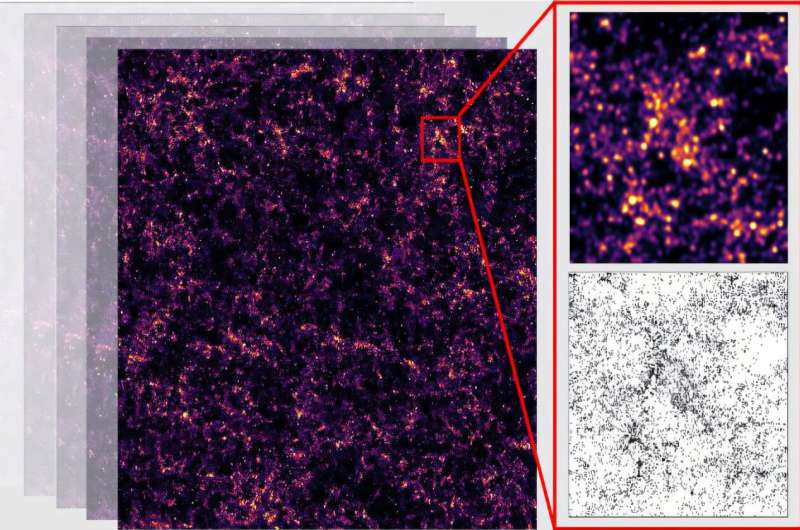Astrophysicists have long been fascinated by the mystery of the universe’s formative years. Yet, despite advanced telescopes, our cosmic understanding remains limited. The newly proposed method of line intensity mapping offers a fresh way to explore these uncharted times, pushing past the boundaries of current imaging technology.
Why Current Methods Fall Short
Reaching further back into the universe’s history is no simple feat. Traditional high-resolution telescopes, like those used for deep-sky surveys, provide detailed images of individual galaxies. However, they only scratch the surface of the universe’s early years. As Kirit Karkare from the SLAC National Accelerator Laboratory points out, “To understand the big picture of cosmological physics, we need to survey a much larger volume of space.” Current technology, while powerful, leaves nearly 90% of the universe’s history unexplored, a limitation that scientists are eager to overcome.
This gap is especially significant because the early universe holds clues about dark energy, dark matter, and the events that followed the Big Bang. By studying these vast stretches of space, scientists hope to uncover how the universe’s structure evolved, helping us better understand the nature of cosmic expansion and the forces that shaped it.
The Promise of Line Intensity Mapping
Line intensity mapping offers a new way to tackle these challenges. Unlike traditional methods that focus on pinpointing individual galaxies, this technique captures large-scale patterns of light from many galaxies at once. It’s like shifting from a zoomed-in close-up to a panoramic view, providing a broader understanding of cosmic evolution.

Using line intensity mapping, researchers can detect faint, distant galaxies by capturing the overall light emitted by groups of galaxies. This allows scientists to study areas that are otherwise too dim to be captured through standard telescopic imaging. It’s a method that sacrifices some detail for a much more comprehensive view of the universe’s structure.
How SPT-SLIM Takes Us Closer to the Past
The South Pole Telescope Summertime Line Intensity Mapper (SPT-SLIM) represents a key advancement in this field. Developed by a team of scientists from the University of Chicago, the SLAC National Accelerator Laboratory, and other institutions, this new device is designed to map the cosmos more effectively. The instrument, printed on a silicon wafer about the size of a quarter, is set to be installed on the South Pole Telescope, offering a new perspective on the universe’s “in-between years.”
With the ability to measure cosmic light more sensitively than previous instruments, SPT-SLIM promises to open a window into a period of cosmic history that remains largely unobserved. By studying the large-scale light patterns from this era, researchers hope to decode the structure of the universe during its less-understood middle ages, between 600 million and a billion years after the Big Bang.
Peering Into the Universe’s “Teenage” Years
The universe’s teenage years—those formative times when the first galaxies began to mature—are of particular interest to researchers. During this time, galaxies were filled with dust and stars began to form at a rapid pace. These processes laid the groundwork for the structures we see today, including galaxy clusters and star-forming regions.
Line intensity mapping enables scientists to examine these early galaxies and the clouds of dust they contain. The clumps of light detected in these maps provide clues about how stars formed and evolved, offering insight into the dynamic processes that shaped the cosmos. Unlike the precision images from telescopes like the Hubble or James Webb Space Telescopes, these maps reveal the broader story of cosmic evolution.
Why This Research Matters
Understanding this period of the universe’s history isn’t just about satisfying scientific curiosity—it has profound implications for our understanding of fundamental forces like dark matter and dark energy. Dark energy, the mysterious force driving the acceleration of the universe’s expansion, remains one of the biggest questions in modern astrophysics. By studying large-scale structures with line intensity mapping, scientists can test theories about how dark energy influenced the growth of the universe.
Moreover, these insights could reshape our understanding of dark matter, the unseen material that makes up much of the universe’s mass. Observations of how galaxies clump together can reveal how dark matter interacts with ordinary matter, providing critical data to refine our models of the universe’s evolution.
The Role of Technology and Future Missions
As the SPT-SLIM project begins collecting data, researchers are looking forward to the possibilities it opens up for future cosmic exploration. This technology is designed to work in harsh environments, like those found at the South Pole, where the clear, dry air makes for ideal observations. By combining data from SPT-SLIM with other telescopic surveys, scientists hope to create a more complete picture of the universe’s history.
The South Pole location is strategic not just for its clear skies, but also for its ability to observe the southern sky’s rich and dense regions of space. This combination of advanced technology and strategic placement allows for a deeper dive into cosmic mysteries.
What We Can Learn From This Research
The potential findings from SPT-SLIM and line intensity mapping extend beyond the immediate field of astrophysics. They could impact our understanding of the universe’s expansion, inform models of galaxy formation, and even aid in the search for habitable worlds. For instance, studying the dust-rich galaxies of the early universe could provide clues about where conditions for life might have first emerged.
As the data from these new observations come in, researchers will be able to refine models of the universe’s evolution. This may lead to new discoveries about the formation of stars, the role of dark energy, and how galaxies like our own Milky Way came to be. Each piece of information adds to the broader puzzle of the universe’s history, helping us piece together the story of our cosmic origins.
Conclusion: A New Era in Understanding the Cosmos
The development of line intensity mapping and the SPT-SLIM represents a pivotal moment in astrophysics. By enabling us to study the universe’s less-explored middle years, these tools promise to transform our understanding of cosmic evolution. As we peer deeper into the universe’s history, we not only learn about the past but also gain insights into the forces shaping the cosmos today.
Reference:
Karkare, K. S., Anderson, A. J., Barry, P. S., Benson, B. A., Carlstrom, J. E., Cecil, T., Chang, C. L., Dobbs, M. A., Hollister, M., Keating, G. K., Marrone, D. P., McMahon, J., Montgomery, J., Pan, Z., Robson, G., Rouble, M., Shirokoff, E., & Smecher, G. . SPT-SLIM: A Line Intensity Mapping Pathfinder for the South Pole Telescope



















